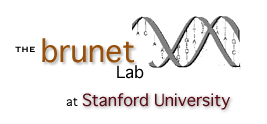1. Greer EL, Maures TJ, Hauswirth AG, Green EM, Leeman DS, Maro, GS, Han S, Banko MR, Gozani O and Brunet A (2010) Members of the H3K4 trimethylation complex regulate lifespan in a germline-dependent manner in C. elegans. Nature, 466: 383-387. Abstract PDF
2. Maures TJ, Greer EL, Hauswirth AG, and Brunet A (2011). H3K27 demethylase UTX-1 regulates C. elegans lifespan in a germline-independent, insulin-dependent, manner. Aging Cell, 10: 980-990. Abstract PDF
3. Greer EL, Maures TJ, Ucar D, Hauswirth AG, Mancini E, Lim JP, Benayoun BA, Shi Y and Brunet A (2011) Transgenerational epigenetic inheritance of longevity in Caenorhabditis elegans. Nature, 479: 365-371. Abstract PDF
4. Maures TJ, Booth LN, Benayoun BA, Izrayelit Y, Schroeder FC and Brunet A (2014) Males shorten the life span of C. elegans hermaphrodites via secreted compounds. Science, 343:541-544. Abstract PDF
5. Benayoun BA*, Pollina EA*, Ucar D*, Mahmoudi S, Karra K, Wong E, Devarajan K, Daugherty AC, Kundaje A, Mancini E, Rando TA, Snyder MP, Baker JC, Cherry M and Brunet A (2014) H3K4me3 breadth is linked to cell identity and transcriptional consistency. Cell, 158: 673-688. Abstract PDF
6. Benayoun BA*, Pollina EA* and Brunet A (2015) Epigenetic regulation of aging: linking environmental input to genomic stability. Nature Review Mol Cell Biol, 16:593-610. Abstract PDF
7. Booth LN and Brunet A (2016) The aging epigenome. Mol Cell, 62:728-44. Abstract PDF
8. Han S, Schroeder EA, Silva-Garcia CG, Hebestreit K, Mair WB and Brunet A (2017) Mono-unsaturated fatty acids link H3K4me3 modifiers to C. elegans lifespan. Nature, 544: 185-190. Abstract PDF
9. Daugherty AC*, Yeo RW*, Buenrostro JD, Greenleaf WJ, Kundaje A, and Brunet A (2017) Chromatin accessibility dynamics reveal novel functional enhancers in C. elegans. Genome Research, 27: 2096-2107. Abstract PDF
10. Benayoun BA, Pollina EA, Singh PP, Mahmoudi S, Harel I, Casey K, Dulken B, Kundaje A and Brunet A (2019) Remodeling of epigenome and transcriptome landscapes with aging in mice reveals widespread induction of inflammatory responses. Genome Research, 29:697-709. Abstract PDF

